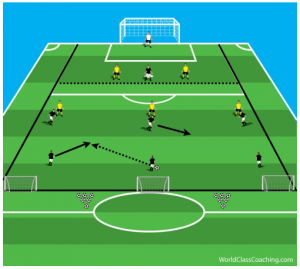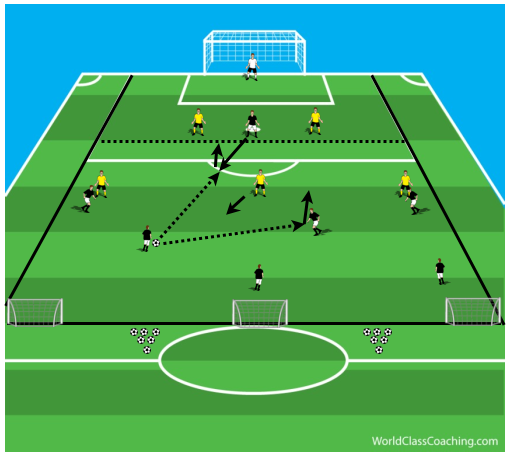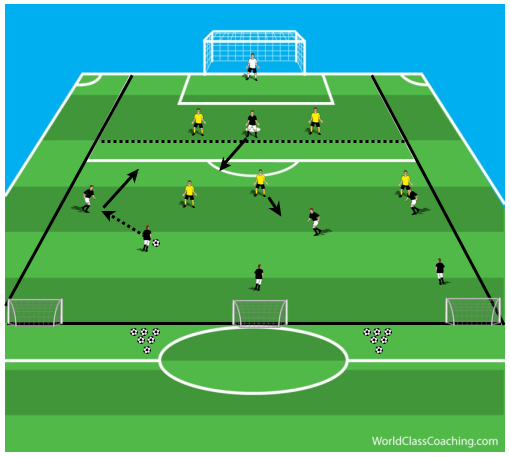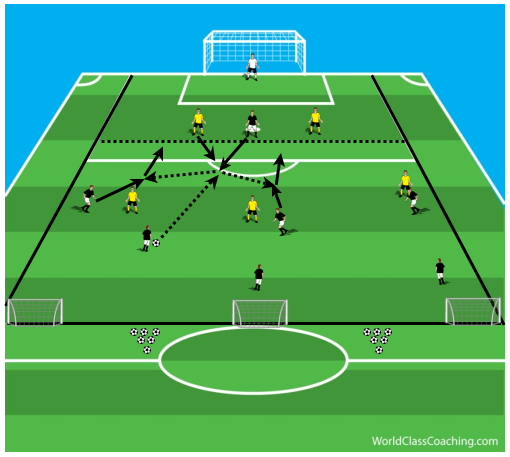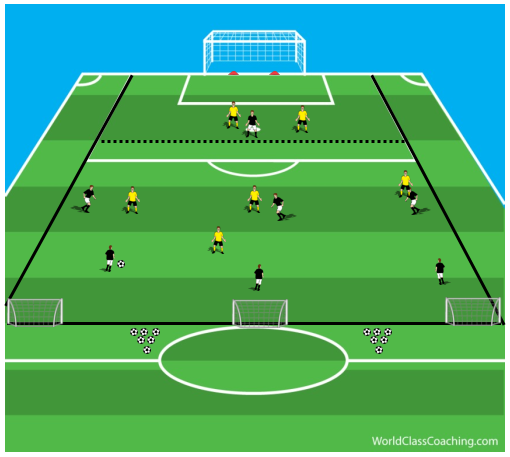By Sean Pearson
Area Size: 40 x 35 Yards
Teams: 7 v 6
Time: 20-25 Minutes
Objectives
- To be more direct when the scenario presents itself
- To pass to players with open shoulders
- Be positive in your play
When we hear the term ‘direct play’ a lot of players/coaches automatically think of the long ball or as some know it ‘route 1’. Why is this all we think off? I would like to show you how to be more direct without using a long ball. Let me first say that having a ‘long ball’ in your arsenal is no bad thing, I think if your team are able to use it to its advantages then that can only be good, all I am saying here is we can be more direct without just using a long ball.
This session is based around formation play for coaches who utilize a 3-3-1 formation for 8v8 teams but it can also be adapted for any formation you choose as well as 11v11 formations. Set up your 3-3-1 formation as below against a GK and a 2-3. I realize there is no pressure on the defending players in the 3-3-1 but I am working off an 8v8 team having a maximum of 13 players on their roster, so I do not want to magic a player up who may not be there. If you have 14 then yes have a striker for the defending team.
Each time your team start aim for the CB to start with the ball, tell your CM to move to one side or the other. Your CB should then proceed to pass the ball to the opposite FB, who comes off their line. This now causes the defending team problems. Where do they go?
Notice I have a zone near the goal for the GK, 2 defenders and your striker. Whenever your team starts with possession all 4 players must be in this zone. The reason is young players do like to come towards the ball all the time. They need guidance as to when is the right moment to do so. This line restricts the striker’s natural impulse to come forward and therefore leaves space to move into at the right time. The visual trigger for the striker to drop into the space is when the FB looks up. This tells the striker the FB is looking to pass the ball. As the striker drops they do so with an open body shape to receive the ball, this is so they can potentially go forwards.
Also the CM has moved away from their respective CM and also has open body position. The FB aims to pass the ball to their back foot so the CM can touch the ball forwards and attack. In both instances communication triggers are needed. Players need to call ‘turn’ to the striker and ‘drive’ to the CM. Drive is a communication trigger I use when I want a player to sprint with the ball into space, effectively running with the ball NOT dribbling.
If the two players block these passing lines off there is the pass to the wide midfielder’s back foot and with their first touch they drive towards goal and not down the line, therefore being more direct.
When your team is successful at manipulating the two midfielders allow a defender to follow the striker once they drop into the space. Now as the ball travels into the striker the communication trigger is ‘set’ by either the CM or WM. As the ball breaks the line of the midfielders both you CM and WM run behind them so they can’t be seen. When the striker drops into the space they either face left or right. This tell your midfielders who will receive the ball as the set should be done with the back foot so the striker can see the defender and then spin behind them after the set. When the midfielder receives the ball they advance forwards at pace. AS soon as this happens it is free play and players can move anywhere. If the defending team win possession they attack one of the 3 goals.
Below you see what the layout of the session would look like if you only had 13 and wanted to use a striker instead of a GK. In the goal you would put 2 cones, players have to score in the corners with a one time finish. This now adds more pressure to the defending positions on your team.
Coaching Points
- Look for players with open shoulder to pass to
- Receive on the back foot and look to go forwards
- Communicate with each other
- Look to be positive and go forwards as often as possible.
Variations
- 2-3-2 Formation
- If you have enough players you can do 3-3-1 v 2-3-2
By Sean Pearson. Sean is also the author Coaching Team Shape in the 3-3-1, Coaching Team Shape in the 4-2-3-1 and Coaching Team Shape in the 4-3-3

